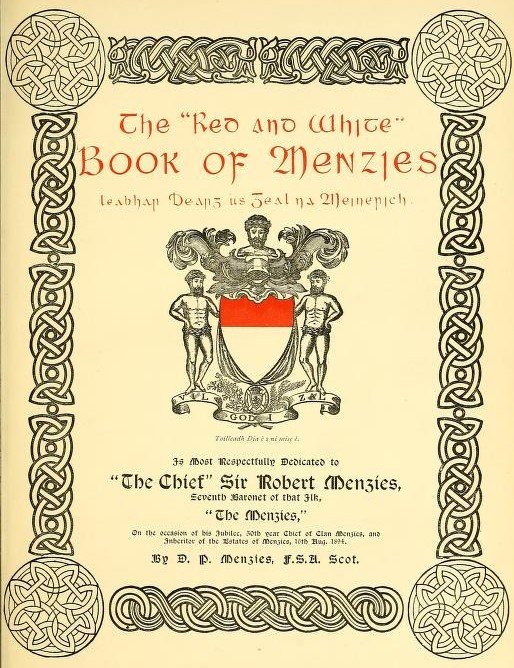D.P. Menzies, The ‘Red and White’ Book of Menzies: The History of Clan Menzies and its Chiefs (1894)
Robert Menzies was famously a supporter of the Carlton ‘Blues’, but arguably he should have gone for the Swans or Dragons. This is because red and white have been the Menzies family colours for centuries.
Published the year that Menzies was born, and ironically dedicated to a different ‘Sir Robert Menzies’ (the book reveals that there have been many over the years), The ‘Red and White’ Book of Menzies traces the family history all the way back to 333 B.C. This was when King Fergus, first ruler of the Scots, is said to have reigned over Albion (the ancient name for Britain). He had two sons, the second of whom was called Maynus (a name which would evolve into Menzies). Maynus became King of Scotland in 300 B.C. and earned a reputation as an upholder of justice and lover of peace, who unusually for the time period managed to avoid engaging in any wars throughout his reign.
A devoutly religious, albeit pre-Christian, man, Maynus made a lasting impact on the Scottish landscape:
‘It has been acknowledged by all writers that the… Menzies have always been a peacefully disposed clan. And it is also a well-known fact that in the Menzies country there are a large number of standing stones and several stone circles, the most perfect circle being on the old Menzies’ lands of Stix or Stuic, near Kenmore, about four miles west from Aberfeldy, confirming by their silent presence the tale of the ancient chroniclers, that Maynus had “huge stains drawin togidder in forme of circles,” for the worship of the people; indeed, the whole ancient and present country of the Menzies is bristling with these ancient reliques of a dead religion, whose founder was the first Menzies. With such religious stones his name is inseparably connected. Mainner in Gaelic means “enclosure of stones,” and maen in Welsh Gaelic means “stones of the ancients.”’
It was to Maynus that the Menzies could trace their long affiliation with the colours red and white, as related in this verse:
‘The first of Scottish Kings that Albion boasts,
Who oft to victory led the Scottish hosts,
Was Fergus, Ferchad’s son, whose mighty shield
Bore a Red Lion on a yellow field;
Three hundred years and thirty was his reign,
Before Christ came to break sin’s deadly chain.
Maynus the second son of King Fergus was,
Who on his shield emblazoned bore
A Red Chief on a white field.’
The book goes on to trace prominent Menzies for over 20 centuries. Such as Meanius the good, who 18 generations after Maynus converted to Christianity and began preaching the message of the crucifixion throughout Scotland. There was also Maianus, who 37 generations after Maynus was exiled by MacBeth to Europe, where he became a Professor of Theology and Mathematics in Ratisbon, located in modern Germany. By the 12th century, the name had reached a more recognisable form, as Chief Sir Robert the Mengyies served as Regent and Lord High Chamberlain of Scotland. To this day, Menzies is pronounced in Scotland as ‘Ming-ies’, hence how Australia’s Sir Robert earned the nickname ‘Ming’.
These tales of various Menzies reach all the way up to the British settlement of Australia, recording how a Dr John Menzies, graduate of the University of Edinburgh, moved down under in the 1840s. More broadly, the book documents how it was losing possession of their ancestral lands that forced many Menzies to emigrate to the new world.
A common touchstone in Sir Robert’s speeches is the importance of ‘a sense of continuity’. He argued that ‘the man who feels pride in the past and a sense of responsibility for the future, though he may be called “dour”, or “canny”… does much for development and growth and the stability of society.’ Menzies ascribed his own profound sense of continuity to his Scottish heritage. Reading The ‘Red and White’ Book of Menzies it is easy to see how he saw himself as taking up a place in ‘the grand procession’.
Sign up to our newsletter
Sign up for our monthly newsletter to hear the latest news and receive information about upcoming events.


